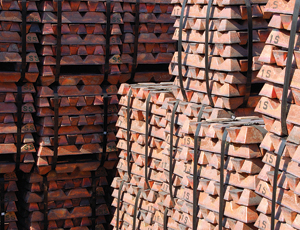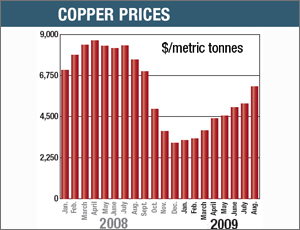China went on a commodity buying binge during the last eight months, snapping up materials that had tumbled from record high levels during the first quarter of 2008 to bargain prices by the beginning of this year. The Chinese purchases were so significant that they were primarily responsible for the recent rebound in global prices for a number of commodities, say industry sources.


“There’s been a massive increase in imports of aluminum, copper and, to a lesser extent, zinc and iron ore, not for consumption but held by the [metals] trade in storage, sitting at the trader’s warehouses and at the ports,” says Stuart Burns, managing director for Europe and Asia at Aptium Global, Chicago.
In a brief to the World Trade Organization, U.S. Trade Rep. Ron Kirk complained, “China’s measures appear to be a troubling industrial policy aimed at providing substantial competitive advantages for Chinese industries.” In effect, China keeps some of these raw materials out of the global marketplace, thereby allowing its domestic industries access to lower-priced products while simultaneously creating supply constraints for overseas companies, forcing them to pay higher prices, he concluded.
Some of these “overseas companies” are U.S. contractors who are already paying substantially higher prices for some materials. “Copper has doubled and aluminum is up 50% from their lows, but prices are still below the highs of a few years ago,” says Karl Almstead, chief estimator for Turner Construction Co., New York City.
During the last eight months China bought roughly 500,000 tonnes of aluminum, says John Mothersole, an economist with IHS Global Insight, Washington, D.C. That alone increased global inventories by about 10%, he says. During the same period, China bought about 300,000 tonnes of copper, while the remaining global inventory was 470,000 tonnes.
Such a massive expansion of global inventory gave prices quite a kick. Aluminum prices increased from a low of $1,330 per tonne last February to $1,934 per tonne in August. Copper prices jumped from a low of $3,071 per tonne at the end of last year to $6,165 per tonne now.
But these prices should be nearing their peak. “Commodity prices have moved ahead of market fundamentals,” says Mothersole. He is forecasting a modest correction in prices over the next eight months.
“China’s inventory buildup appears to be slowing, and we have seen some selling back as China takes advantage of the higher prices,” says Mothersole.
In addition, he says there is plenty of capacity for the eventual recovery to grow into, which will help cap prices. Markets now are just moving off of the bottom of the global recession with full recovery still to come, so the demand for Chinese exports is not yet there, he says.
As a result, Global Insight is forecasting that by the second quarter of next year copper prices will have slipped back to $5,400 per tonne, while aluminum prices dip to $1,785 per tonne.
However, after mid-2010, prices will start to strengthen again, Mothersole predicts. He sees copper prices climbing back to $6,100 a tonne and expects aluminum prices to bounce back to $1,960 per tonne by the end of 2011.


Post a comment to this article
Report Abusive Comment